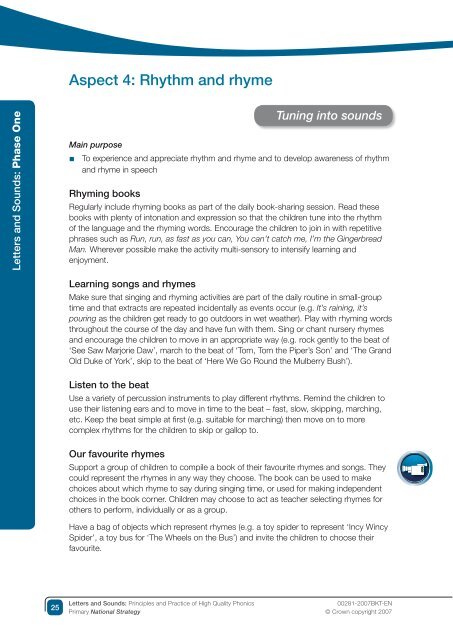Letters and Sounds 1
Letters and Sounds 1
Letters and Sounds 1
You also want an ePaper? Increase the reach of your titles
YUMPU automatically turns print PDFs into web optimized ePapers that Google loves.
<strong>Letters</strong> <strong>and</strong> <strong>Sounds</strong>: Phase One<br />
Aspect : Rhythm <strong>and</strong> rhyme<br />
Main purpose<br />
<strong>Letters</strong> <strong>and</strong> <strong>Sounds</strong>: Principles <strong>and</strong> Practice of High Quality Phonics<br />
Primary National Strategy<br />
Tuning into sounds<br />
■ To experience <strong>and</strong> appreciate rhythm <strong>and</strong> rhyme <strong>and</strong> to develop awareness of rhythm<br />
<strong>and</strong> rhyme in speech<br />
Rhyming books<br />
Regularly include rhyming books as part of the daily book-sharing session. Read these<br />
books with plenty of intonation <strong>and</strong> expression so that the children tune into the rhythm<br />
of the language <strong>and</strong> the rhyming words. Encourage the children to join in with repetitive<br />
phrases such as Run, run, as fast as you can, You can’t catch me, I’m the Gingerbread<br />
Man. Wherever possible make the activity multi-sensory to intensify learning <strong>and</strong><br />
enjoyment.<br />
Learning songs <strong>and</strong> rhymes<br />
Make sure that singing <strong>and</strong> rhyming activities are part of the daily routine in small-group<br />
time <strong>and</strong> that extracts are repeated incidentally as events occur (e.g. It’s raining, it’s<br />
pouring as the children get ready to go outdoors in wet weather). Play with rhyming words<br />
throughout the course of the day <strong>and</strong> have fun with them. Sing or chant nursery rhymes<br />
<strong>and</strong> encourage the children to move in an appropriate way (e.g. rock gently to the beat of<br />
‘See Saw Marjorie Daw’, march to the beat of ‘Tom, Tom the Piper’s Son’ <strong>and</strong> ‘The Gr<strong>and</strong><br />
Old Duke of York’, skip to the beat of ‘Here We Go Round the Mulberry Bush’).<br />
Listen to the beat<br />
Use a variety of percussion instruments to play different rhythms. Remind the children to<br />
use their listening ears <strong>and</strong> to move in time to the beat – fast, slow, skipping, marching,<br />
etc. Keep the beat simple at first (e.g. suitable for marching) then move on to more<br />
complex rhythms for the children to skip or gallop to.<br />
Our favourite rhymes<br />
Support a group of children to compile a book of their favourite rhymes <strong>and</strong> songs. They<br />
could represent the rhymes in any way they choose. The book can be used to make<br />
choices about which rhyme to say during singing time, or used for making independent<br />
choices in the book corner. Children may choose to act as teacher selecting rhymes for<br />
others to perform, individually or as a group.<br />
Have a bag of objects which represent rhymes (e.g. a toy spider to represent ‘Incy Wincy<br />
Spider’, a toy bus for ‘The Wheels on the Bus’) <strong>and</strong> invite the children to choose their<br />
favourite.<br />
00281-2007BKT-EN<br />
© Crown copyright 2007
















